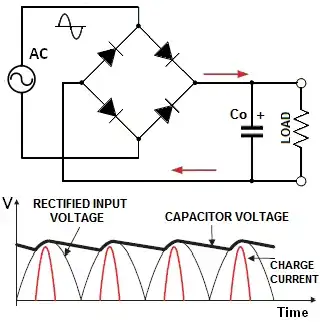A capacitor can be used to correct the power-factor on an inductive load. This is typically done on industrial motor and fluorescent loads which are famously inductive. This works because both the inductive and capacitive currents are sinusoidal and 180° out of phase. If the \$ I_C = I_L \$ then they cancel out. See my answers to Why do we want higher power factor in ac motors? and How do capacitors improve power factor without destroying the capacitor? for more on this.
Your question reads as though you think that adding a capacitor to an unspecified DC power supply will improve the power factor. It may make it worse.

Figure 1. A simple full-wave rectified power supply. Note that current (red) is only drawn from the supply when the rectified AC voltage exceeds the voltage on the capacitor. Increasing the value of \$ C_O \$ only makes this worse. Source: PowerFactor.US.
Adding the capacitor on the AC side can't correct the narrowness of the current pulses. See the linked article for more on active power-factor correction for these situations.
